Making Living Streets, from the NYC exhibit to your community...
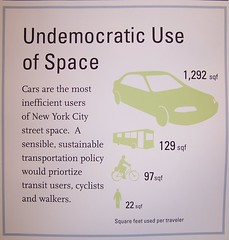 Exhibit panel, Living Streets Exhibit, NYC.
Exhibit panel, Living Streets Exhibit, NYC.The New York City Street Renaissance Campaign is a joint effort by a number of groups working to better "balance" mobility resources vs. fealty to the car. In Manhattan, 80% of the residents don't have cars, yet much of the public space is devoted to car usage.
The campaign has sponsored a Living Streets Exhibit at the Municipal Arts Society (and lecture-organizing series) to get people talking about these issues. They're basic issues true, but need to be repeated constantly, because people plan, design, and advocate for the car without even questioning it. (Even in NYC...)
The companion website has a lot more information, more videos than were shown in the Exhibit, etc.

I am actually not a car hater, but I take an extreme position because pro-car lobbying forces-- ranging from regional affiliates of the American Automobile Association to the industry to the average resident--encourage the maintenance and strengthening of planning and transportation practices that put private automobile interests front and center.
Recent examples include:
- opposition to providing public space (designated parking spaces) to car sharing services, ostensibly because the car sharing services are for-profit companies, not looking at the overall impact of reducing the total number of cars seeking to park on city streets;
- opposition to increases in parking permit prices, and scaling prices according to the number of cars in a household, and limiting the number of permits to three per household (note that the street space in front of the average rowhouse can only accommodate one car, even small cars in the U.S. range from 12-14 feet long, and The Common Denominator, normally a decent good government oriented newspaper editorialized in favor of providing neighborhood parking structures!!!!!!!!!!!!, my unpublished communication to the editor started out stating that such a recommendation is "insane");
- calls for special parking permits for teachers at a Columbia Heights school, because they have to leave school throughout the day to move their cars, which are parking in residential permit zones--yet DC Public Schools don't participate in pro-transit usage programs (Metrochek) and DC schoolteachers expect free onsite parking generally);
Clearly, a comprehensive look at these issues is required, and people aren't doing it. Institutions like churches and schools ought to be required to produce and maintain transportation demand management programs aimed at reducing individual car trips. Such a requirement should include charter schools which likely generate upwards of 500 car trips/ day for each school. Businesses should be encouraged to receive truck deliveries at night, when there is little traffic on the streets, etc.

It's funny to talk with NYC activists about how bad it is in NYC when for those of us in the rest of the country, we see NYC as #1 in terms of pro-pedestrianism and as the one place where residents don't feel entitled to street parking. Parking fees and taxes there are extremely high and there is a recognition that making car ownership easier is counter-productive.
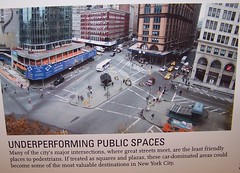
Still, we can learn from our colleagues in NYC, and we can be inspired by them, because at times it's hard to "keep hope alive" when you argue the same point over and over and over and over again, such as in Columbia Heights, site of the schoolteacher parking issue, where one person said it's necessary to widen DC roads for cars, as well as to provide parking lots throughout neighborhoods. Ugh.

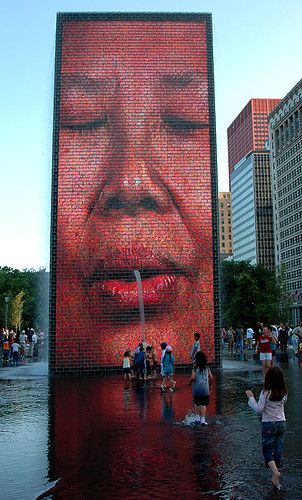 Sculpture at Millennium Park, Chicago.
Sculpture at Millennium Park, Chicago.And DC is doing a lot more than a lot of communities in terms of rebalancing mobility planning, and in focusing on public space and streetscape improvement. One such project is the reconstruction of Thomas Circle to more of a park-like setting comparable to Dupont Circle, instead of an inaccessible micro-greenspace scarred by multiple street travel lanes.
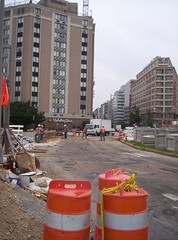 Thomas Circle under reconstruction.
Thomas Circle under reconstruction.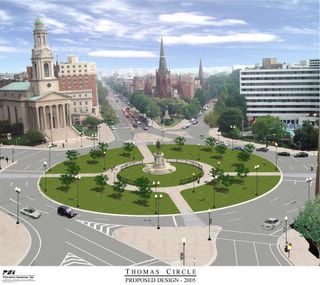 Rendering of Thomas Circle after reconstruction.
Rendering of Thomas Circle after reconstruction.But even so, it is a constant constant struggle to do this up against the pro-car forces, that unfortunately seem to build with each new household coming to the District, a household that hasn't shucked off suburban planning and transportation practices, and applies these ill-fitted approaches to city planning and transportation questions which require urban-oriented and friendly answers.
Index Keywords: mobility; car-culture; walking



0 Comments:
Post a Comment
<< Home